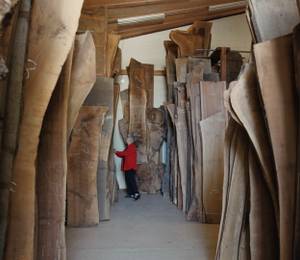Washington, D.C., USA – The Cultural Landscape Foundation (“TCLF”) announced that Julie Bargmann is the winner of the inaugural Cornelia Hahn Oberlander International Landscape Architecture Prize (“Oberlander Prize”). The biennial Oberlander Prize, which includes a $100,000 award, two years of public engagement activities focused on the laureate’s work and landscape architecture more broadly and is named for the late landscape architect Cornelia Hahn Oberlander, is bestowed on a recipient who is “exceptionally talented, creative, courageous, and visionary” and has “a significant body of built work that exemplifies the art of landscape architecture.”
The Oberlander Prize Jury Citation notes of Bargmann: “She has been a provocateur, a critical practitioner, and a public intellectual. She embodies the kind of activism required of landscape architects in an era of severe environmental challenges and persistent social inequities.”
Bargmann, a native of Westwood, NJ, is a Professor of Landscape Architecture at the University of Virginia in Charlottesville, VA, and the founder of D.I.R.T. (“Dump It Right There”) studio. She earned a Bachelor of Fine Arts in Sculpture from Carnegie Mellon University and a Master in Landscape Architecture at Harvard’s Graduate School of Design (1987). In 1989-90 she was a Fellow in Landscape Architecture at the American Academy in Rome.
The Oberlander Prize Jury met virtually in June, July and August 2021 to select the inaugural laureate, due to the global novel coronavirus pandemic and the necessity for social distancing. According to Dorothée Imbert, Chair of the seven-person international Oberlander Prize Jury, qualities that made Bargmann stand out include: “her leadership in the world of ideas, her impact on the public landscape, her model of an activist practice, and her commitment to advancing landscape architecture both through teaching and design.” As Bargmann has said of herself: “The two ends of my barbell are designer-artist and political animal.”
For more than 30 years as a teacher and a landscape architect, Julie Bargmann has principally focused on contaminated, neglected, and forgotten urban and post-industrial sites. According to Bargmann: “Unearthing the raw ingredients of design from waste and wastelands defines my life’s work. Both the pedagogy of my teaching and my methodology as a designer address the social and ecological imperatives to reclaim degraded land. Integrating regenerative technologies with design propositions and built landscapes embodies my contribution to the discipline of landscape architecture.” Since she started teaching and founded D.I.R.T. studio, she has created alternatives to counter the limitations of typical remediation (defined as “correcting a fault”) by offering more dynamic modes of regeneration (or, “creating anew”).
For many of her recent projects, Bargmann and D.I.R.T. have acted as the conceptual design lead, working with other experts throughout the planning and design process, and sticking with many projects through construction. Multi-disciplinary collaborations with architects, historians, engineers, hydrogeologists, artists, and, most importantly, the residents of the area in which she is working, are hallmarks of Bargmann’s approach. Artistically, she is strongly influenced by the work and writings of Robert Smithson, the American artist known for his land art installations including Spiral Jetty, and the American artist Eva Hesse. Bargmann describes her approach as “rigorous intuition or intuitive rigour.”
















